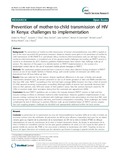| dc.description.abstract | Background
The prevention of mother-to-child transmission of human immunodeficiency virus (HIV) is lauded as one of the more successful HIV prevention measures. However, despite some gains in the prevention of mother-to-child transmission of HIV (PMTCT) in sub-Saharan Africa, mother-to-child transmission rates are still high. In Kenya, mother-to-child transmission is considered one of the greatest health challenges and scaling up PMTCT services is crucial to its elimination by 2015. However, guideline implementation faces barriers that challenge scale-up of services. The objective of this paper is to identify barriers to PMTCT implementation in the context of a randomized control trial on the use of structured mobile phone messages in PMTCT.
Methods
The preliminary analysis presented here is based on survey data collected during enrolment in PMTCT services at one of two health facilities in Nairobi, Kenya, with overall number of antenatal care (ANC) visits determined from 48 hour follow up data.
Results
Data was collected for 503 women. Despite significant differences in the type of facility and sample characteristics between sites, all women presented to care at 20 weeks gestation or later and 88.8% attended less than four ANC visits. PMTCT counselling at first visit had high coverage (86%), however less than a third of women (31.34%) reported receiving contraception counselling. Although 60.8% of women had reportedly disclosed their status to their partners, only 40% were aware of their partner’s status. Very few women had been tested for TB (10%) or received single dose nevirapine during their first antenatal care appointment (20%).
Conclusion
Revised PMTCT guidelines aim to reduce the inequity between PMTCT services in high and low resource settings in efforts to eliminate mother-to-child transmission. However, guideline implementation in low resource settings continues to be confronted with challenges related to late presentation, less than four ANC visits, low screening rates for opportunistic infections, and limited contraception counselling. These challenges are further complicated by lack of disclosure to partners. Effective scale up and implementation of PMTCT services requires that such ongoing program challenges be identified and appropriately addressed within the local context. | en_US |


